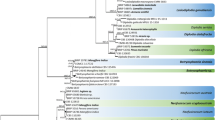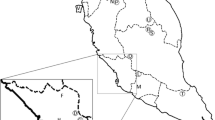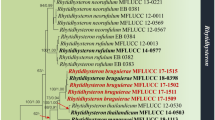Abstract
Unidentified black spots (or stains) appeared on the plaster walls of the Takamatsuzuka and Kitora Tumuli in the village of Asuka, Nara Prefecture, Japan. Public attention was drawn to the biodeterioration of the colorful 1,300-year-old murals. A total of 46 isolates of Acremonium sect. Gliomastix were obtained from various samples (mainly black spots) of the Takamatsuzuka Tumulus (TT) (sampling period, May 2004–December 2006) and the Kitora Tumulus (KT) (June 2004–May 2007). These isolates were assignable to four known taxa and a new species in the ‘series Murorum’ sensu W. Gams as inferred from the integrated analysis of phenotypic and genotypic (i.e., ITS and 28S rDNA-D1/D2 sequences) characters: these were Acremonium masseei, A. murorum, A. felinum comb. nov. with the neotype designation, A. polychromum, and A. tumulicola sp. nov., which have been accommodated in the validated series Murorum in the section Gliomastix. The black spots on the murals of the TT and KT were caused mainly by A. masseei and A. murorum, respectively.









Similar content being viewed by others
References
Arai H (1984) Microbiological studies on the conservation of mural paintings in tumuli. In: Ito N, Emoto Y, Miura S (eds) International symposium on the conservation and restoration of cultural property: conservation and restoration of mural paintings (1). Tokyo National Institute of Cultural Properties, Tokyo, pp 117–124
Arai H (1987) Microbiological environments and the counterplan for the Takamatsuzuka Tumulus mural paintings (in Japanese). In: The Agency for Cultural Affairs (ed) National treasures, the Takamatsuzuka Tumulus mural paintings: conservation and repair (in Japanese). The Agency for Cultural Affairs, Tokyo, pp 186–196
Arai H, Kenjo T, Nakasato T, Miura S, Mori H, Emoto Y, Ito N (1991) Studies on the conservation of Shinto and Buddhist buildings in Nikko designated as national treasure and important cultural property (in Japanese). Sci Conserv 30:65–128
Bastian F, Alabouvette C (2009) Lights and shadows on the conservation of a rock art cave: the case of Lascaux Cave. Int J Speleol 38:55–60
Bastian F, Jurado V, Nováková A, Alabouvette C, Saiz-Jiménez C (2010) The microbiology of Lascaux Cave. Microbiology 156:644–652
Berner M, Wanner G, Lubitz W (1997) A comparative study of the fungal flora present in medieval wall paintings in the chapel of the castle Herberstein and in the parish church of St. Georgen in Styria, Austria. Int Biodeterior Biodegrad 40:53–61
Bills GE, Foster MS (2004) Formulae for selected materials used to isolate and study fungi and fungal allies. In: Mueller GM, Bills GF, Foster MS (eds) Biodiversity of fungi: inventory and monitoring methods. Elsevier, Amsterdam, pp 595–618
Caneva G, Nugari MP, Salvadori O (2008) Plant biology for cultural heritage. The Getty Conservation Institute, Los Angeles
Ciferri O (1999) Microbial degradation of paintings. Appl Environ Microbiol 65:879–885
Crous PW, Verkley GJM, Groenewald JZ, Samson RA (eds) (2009) Fungal biodiversity. CBS-KNAW Fungal Biodiversity Centre, Utrecht, p 62
Dhawan S, Garg KL, Pathak N (1993) Microbial analysis of Ajanta wall paintings and their possible control in situ. In: Toishi K, Arai H, Kenjo T, Yamano K (eds) Biodeterioration of cultural property 2. International Communications Specialists, Tokyo, pp 245–262
Diakumaku E, Gorbushina AA, Krumbein WE, Panina L, Soukharjevski S (1995) Black fungi in marble and limestones: an aesthetical, chemical and physical problem for the conservation of monuments. Sci Total Environ 167:295–304
Dickinson CH (1968) Gliomastix Guéguen. Mycol Pap 115:1–24
Domsch KH, Gams W, Anderson T-H (2007) Compendium of soil fungi, 2nd edn. IHW-Verlag, Eching
Dupont J, Jacquet C, Dennetière B, Lacoste S, Bousta F, Orial G, Cruaud C, Couloux A, Roquebert M-F (2007) Invasion of the French Paleolithic painted cave of Lascaux by members of the Fusarium solani species complex. Mycologia 99:526–533
Emoto Y, Emoto Y (1974) Microbiological investigation of ancient tombs with paintings: Ozuka tomb in Fukuoka and Chibusan tomb in Kumamoto (in Japanese). Sci Conserv 12:95–102
Felsenstein J (1985) Confidence limits on phylogenetics: an approach using the bootstrap. Evolution 39:783–791
Gams W (1971) Cephalosporium-artige Schimmelpilze (Hyphomycetes). Gustav Fischer Verlag, Stuttgart
Gams W (1975) Cephalosporium-like hyphomycetes. Trans Br Mycol Soc 64:389–404
Gams W, van der Aa HA, van der Plaats-Niterink AJ, Samson SA, Stalpers JA (1987) CBS course of mycology, 3rd edn. Centraalbureau voor Schimmelcultures, Baarn
Garg KL, Jain KK, Mishra AK (1995) Role of fungi in the deterioration of wall paintings. Sci Total Environ 167:255–271
Glenn AE, Bacon CW, Price R, Hanlin RT (1996) Molecular phylogeny of Acremonium and its taxonomic implication. Mycologia 88:369–383
Guéguen F (1905) Gliomastix (Torula) chartarum n. gen. n. sp.; contribution à l’étude de la formation endogène des conidies. Bull Soc Mycol Fr 21:230–241
Guglielminetti M, Morghen CG, Radaelli A, Bistoni F, Carruba G, Spera G, Caretta G (1994) Mycological and ultrastructural studies to evaluate biodeterioration of mural paintings: detection of fungi and mites in frescos of the Monastery of St. Damian in Assisi. Int Biodeterior Biodegrad 33:269–283
Hammill TM (1970) Paecilomyces clavisporis sp. nov., Trichoderma saturnisporum sp. nov., and other noteworthy soil fungi from Georgia. Mycologia 62:107–122
Hammill TM (1981) On Gliomastix murorum and G. felina. Mycologia 73:229–237
Huelsenbeck JP, Ronquist F (2001) MrBAYES: Bayesian inference of phylogenetic trees. Bioinformatics 17:754–755
Hughes SJ (1958) Revisiones Hyphomycetum aliquot cum appendice de nominibus rejiciendis. Can J Bot 36:727–836
Hughes SJ, Dickinson CH (1968) New Zealand fungi 11. Gliomastix Guéguen. N Z J Bot 6:106–114
Karbowska-Berent J (2003) Microbiodeterioration of mural paintings: a review. In: Koestler RJ, Koestler VH, Charola AE, Nietro-Fernandez FE (eds) Art, biology, and conservation: biodeterioration of works of art. The Metropolitan Museum of Art, New York, pp 267–301
Kigawa R, Sano C, Ishizaki T, Miura S (2006) Concept and measures of the conservation of Takamatsuzuka Tumulus for thirty years and the present situation of biodeterioration (in Japanese). Sci Conserv 45:33–58
Kigawa R, Sano C, Ishizaki T, Miura S (2007a) Circumstances of microorganisms in Takamatsuzuka Tumulus in 2006 (in Japanese). Sci Conserv 46:209–219
Kigawa R, Sano C, Mabuchi H, Miura S (2007b) Investigation of issues in Kitora Tumulus during its restoration work (3) (in Japanese). Sci Conserv 46:227–233
Kigawa R, Mabuchi H, Sano C, Miura S (2008) Biological issues in Kitora Tumulus during relocation work of the mural paintings (2007) (in Japanese). Sci Conserv 47:129–133
Kigawa R, Sano C, Ishizaki T, Miura S, Sugiyama J (2009) Biological issues in the conservation of mural paintings of Takamatsuzuka and Kitora tumuli in Japan. In: Sano C (ed) International symposium on the conservation and restoration of cultural property: study of environmental conditions surrounding cultural properties and their protective measures. National Research Institute for Cultural Properties, Tokyo, Tokyo, pp 43–50
Kiyuna T, An K-D, Kigawa R, Sano C, Miura S, Sugiyama J (2008) Mycobiota of the Takamatsuzuka and Kitora tumuli in Japan, focusing on the molecular phylogenetic diversity of Fusarium and Trichoderma. Mycoscience 49:298–311
Korneup A, Wanscher JH (1978) Methuen handbook of colour, 3rd edn. Eyre Methuen, London
Kumar S, Tamura K, Nei M (2004) MEGA3: integrated software for molecular evolutionary genetics analysis and sequence alignment. Brief Bioinform 5:150–163
Lechat C, Farr DF, Hirooka Y, Minnis AM, Rossman AY (2010) A new species of Hydropisphaera, H. bambusicola, is the sexual state of Gliomastix fusigera. Mycotaxon 111:95–102
Matsushima T (1975) Icones microfungorum a Matsushima lectorum. Published by the author, Kobe
Mau B, Newton M, Larget B (1999) Bayesian phylogenetic inference via Markov chain Monte Carlo methods. Biometrics 55:1–12
Nieto-Fernández FE, Centeno SA, Wypyski MT, Di Bonaventura MP, Baldwin AM, Koestler RJ (2003) Enzymatic approach to removal of fungal spots from drawings on paper. In: Koestler RJ, Koestler VH, Charola AE, Nietro-Fernandez FE (eds) Art, biology, and conservation: biodeterioration of works of art. The Metropolitan Museum of Art, New York, pp 111–127
Nugari MP, Realini M, Roccardi A (1993) Contamination of mural paintings by indoor airborne fungal spores. Aerobiologia 9:131–139
Nylander JAA (2004) MrModeltest 2.2. Program distributed by the author. Evolutionary Biology Centre, Uppsala University
O’Donnell K (1993) Fusarium and its near relatives. In: Reynolds DR, Taylor JW (eds) The fungal holomorph: mitotic, meiotic and plemorphic speciation in fungal systematics. CAB International, Wallingford, pp 225–233
Orial G, Mertz J-D (2006) Lascaux: une grotte vivante. Étude et suivi des phénomènes microbiologiques. Monumental 2:76–87
Orial G, Bousta F, François A (2009) Lascaux cave: monitoring of microbiological activities. In: Sano C (ed) International symposium on the conservation and restoration of cultural property: study of environmental conditions surrounding cultural properties and their protective measures. National Research Institute for Cultural Properties, Tokyo, pp 31–40
Rannala B, Yang Z (1996) Probability distribution of molecular evolutionary trees: a new method of phylogenetic inference. J Mol Evol 43:304–311
Rossman AY, McKemy JM, Pardo-Schultheiss RA, Schroers H-J (2001) Molecular studies of the Bionectriaceae using large subunit rDNA sequences. Mycologia 93:100–110
Saiz-Jiménez C (1995) Microbial melanins in stone monuments. Sci Total Environ 167:273–286
Sano C, Inuzuka M, Mabuchi H, Kigawa R, Yoshida N, Morii M, Kato M, Furihata J, Ishizaki T, Miura S (2008) Environmental conditions of Kitora Tumulus in 2007: monitoring of biological damage (in Japanese). Sci Conserv 47:135–171
Seifert KA, Louis-Seize G, Sampson G (2003) Myrothecium acadiense, a new hyphomycete isolated from the weed Tussilago farfara. Mycotaxon 87:317–327
Sigler L, Zuccaro A, Summerbell RC, Mitchell J, Paré JA (2004) Acremonium exuviarum sp. nov., a lizard-associated fungus with affinity to Emericellopsis. Stud Mycol 50:409–413
Sugiyama J, Kiyuna T, An K-D, Koide T, Kigawa R, Sano C, Miura S (2008) Microbiological survey of the stone chambers of Takamatsuzuka and Kitora tumuli, Nara Prefecture, Japan: a milestone in elucidating the cause of biodeterioration of mural paintings. In: 31st international symposium on the conservation and restoration of cultural property, Tokyo, Japan, Feb. 5–7, pp 34–36
Sugiyama J, Kiyuna T, An K-D, Nagatsuka Y, Handa Y, Tazato N, Hata-Tomita J, Nishijima M, Koide T, Yaguchi Y, Kigawa R, Sano C, Miura S (2009) Microbiological survey of the stone chambers of Takamatsuzuka and Kitora tumuli, Nara Prefecture, Japan: a milestone in elucidating the cause of biodeterioration of mural paintings. In: Sano C (ed) International symposium on the conservation and restoration of cultural property: study of environmental conditions surrounding cultural properties and their protective measures. National Research Institute for Cultural Properties, Tokyo, pp 51–73
Thompson JD, Higgins DG, Gibson TJ (1994) CLUSTAL W: improving the sensitivity of progressive multiple sequence alignment through sequence weighting, positions-specific gap penalties and weight matrix choice. Nucleic Acids Res 22:4673–4680
White TJ, Bruns T, Lee S, Taylor J (1990) Amplification and direct sequencing of fungal ribosomal RNA genes for phylogenetics. In: Innis MA, Gelfand DH, Sninsky JJ, White TJ (eds) PCR protocols: a guide to methods and applications. Academic Press, New York, pp 315–322
Zare R, Gams W, Starink-Willemse M, Summerbell RC (2007) Gibellulopsis, a suitable genus for Verticillium nigrescens, and Musicillium, a new genus for V. theobromae. Nova Hedwig 85:463–489
Zuccaro A, Schulz B, Mitchell JI (2003) Molecular detection of ascomycetes associated with Fucus serratus. Mycol Res 107:1451–1466
Zuccaro A, Summerbell RC, Gams W, Schroers H-J, Mitchell JI (2004) A new Acremonium species associated with Fucus spp., and its affinity with a phylogenetically distinct marine Emericellopsis clade. Stud Mycol 50:283–297
Acknowledgments
Our studies and the reproduction of the portions of the photos shown in Fig. 1 were permitted by the Agency for Cultural Affairs, Japan. We sincerely thank Dr. Walter Gams, one of the reviewers, for his critical comments and helpful suggestions, without which this paper could not have been improved. The comments and suggestions of Dr. Gen Okada as the Editor also helped improving the manuscript. We are grateful to Ms. Carolyn Babcock, Curator of Canadian Collection of Fungus Cultures (CCFC/DAOM) in Ottawa; and the curators of Centraalbureau voor Schimmelcultures (CBS) in Utrecht, RIKEN-Japan Collection of Microorganisms (JCM) in Wako, and NITE-Biological Resource Center (NBRC) in Kazusa for providing the strains (including ex-type) of Acremonium and Gliomastix spp. This study was financially supported in part by a Research Grant from the Institute for Fermentation, Osaka (IFO), to K.-D. An (2008–) and in part by Grants-in-Aid for Scientific Research (A) (No. 17206060 to S.M., 2005–2007; No. 19200057 to C. Sano, 2007–) from the Ministry of Education, Culture, Sports, Science, and Technology, Japan.
Author information
Authors and Affiliations
Corresponding author
Additional information
T. Kiyuna and K.-D. An contributed equally to this work.
About this article
Cite this article
Kiyuna, T., An, KD., Kigawa, R. et al. Molecular assessment of fungi in ‘‘black spots’’ that deface murals in the Takamatsuzuka and Kitora Tumuli in Japan: Acremonium sect. Gliomastix including Acremonium tumulicola sp. nov. and Acremonium felinum comb. nov.. Mycoscience 52, 1–17 (2011). https://doi.org/10.1007/s10267-010-0063-6
Received:
Accepted:
Published:
Issue Date:
DOI: https://doi.org/10.1007/s10267-010-0063-6




